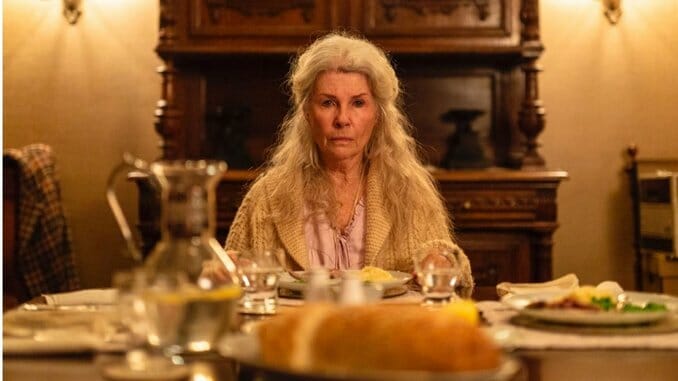Relic Leaves the Crone Behind to Confront Gendered Fears of Aging

If there has been a relatively consistent through-line within the horror genre, it is that there is something uniquely creepy about older people. Elderly women specifically have been portrayed as innately grotesque, their disrobed bodies often enough to provoke a response of guttural unease in the viewer. The 2010s in particular saw an increase in this trope: The unhinged sundowning Nana in The Visit, the baby-snatching sorceress in The Witch, the Scandinavian cult’s nude female elders in Midsommar, the deceptive old lady whose nude jaunt around her kitchen was distinctly unsettling in IT: Chapter 2. These examples, among countless other jump-scare-inducing characters, embody traits symbolizing the crone—an unsightly old hag who often represents death incarnate.
While Natalie Erika James’ Relic focuses on aging family matriarch Edna (Robyn Nevin), the film is interested in much more than a face-value study of the horrors of getting old. After Edna inexplicably disappears from her home, her daughter, Kay (Emily Mortimer), and granddaughter, Sam (Bella Heathcote), travel to her generation-spanning abode, hoping that grandma will find her way back. Edna eventually emerges from the verdant woods surrounding her home, but she is unable to provide details concerning where she was and what she was doing. Kay and Sam believe—to varying degrees—that Edna’s abrupt disappearance was due to gradual cognitive degeneration as a product of her age, but cryptic Post-it notes left around the house by “Nan” point to something sinister controlling her actions.
Relic embarks on a dual journey of dredging up the often unspoken aging anxieties while also ensuring that death, and the moments leading up to it, can provide overwhelming comfort and levity. Edna’s body undergoes an undeniably gruesome transformation—the mysterious bruises that ravage her body mirroring the dark splotches of rot overtaking the home; however, this never compels Kay or Sam to revoke her humanity. While Edna certainly possesses those physical traits associated with the crone figure—long white hair, a bony frame, disheveled appearance—her aging physical body is never offered up as spectacle or shock, instead highlighting the terror of losing autonomy of one’s anatomy.
There is something innately matriarchal about the nature of caregiving and lineage that James and co-writer Christian White evince during the film, namely through the patent generational gaps between the main characters. In Edna, we see a woman who was once a devoted mother, wife and homemaker, left with precious little semblance of her identity after her children grow up, her husband dies and years of accumulated junk and disrepair sully the home she once cared for so well. Kay grapples with the fate of her mother’s future falling squarely into her hands, floundering between the gut instinct to preserve her own independence and ensuring that the woman who raised her is given the same nurturing care during the final years of her life. Sam, a directionless college dropout, wonders if her purpose is to become her Nan’s live-in caretaker to avoid the possibility of sending her to a nursing home. While none of the women effectively understand the unique experiences of their respective elder or descendent, they still maintain an inherent sensitivity through their maternal lineage. In fact, the characters’ extraneous husbands, boyfriends, brothers and other male kin are completely absent from the film, giving the film an aura of unfaltering understanding, even when faced with the disturbing and unknown.